What is the Longest Beach in Hawaii?
One of the longest beaches in Hawaii is Polihale Beach. It is located on the island of Kauai and spans approximately 17 miles. It boasts a rich history and fascinating geology that has captivated locals and visitors alike.

This stunning stretch of coastline resides at the western end of the island. It brims with rugged beauty, secluded nature, and, most importantly, cultural significance.

Polihale Beach spans approximately 17 miles.
©SVongpra/Shutterstock.com
The History of Polihale Beach
For many centuries, Polihale Beach has been a significant location for the Kānaka Maoli people, Native Hawaiians. It holds cultural, spiritual, and historical significance for Native Hawaiians. It is also where ancient Hawaiian culture and stories have been passed down through generations. The name “Polihale” has many mistranslations across the internet. It is best to find accurate information from the source, that being of the Kānaka Maoli people. A loose translation could be translated as hale (house) of po (which has multiple meanings, including “realm of the gods”). It is said to mean “a leaping-off place for spirits” in the Hawaiian language, underscoring the native people’s spiritual and cultural connection with this sacred land.
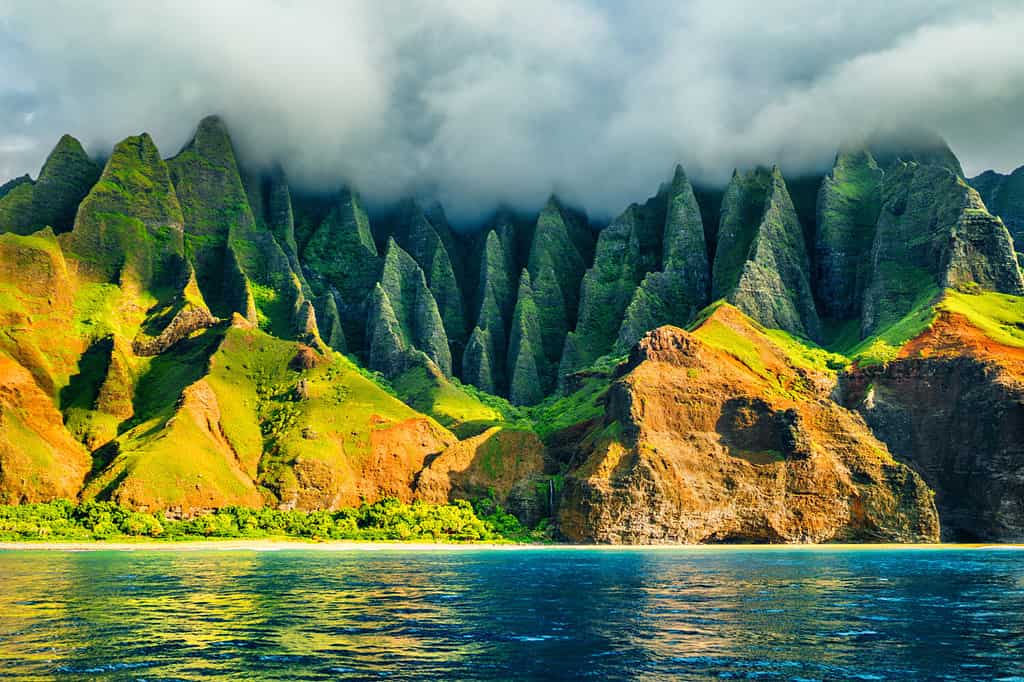
Polihale Beach is located sits at the end of the Na Pali Coast and the edge of the Mana Plains.
©Maridav/Shutterstock.com
The Geology and Geography of Polihale Beach
The formation of Polihale Beach is a result of natural processes that have been shaping the Hawaiian Islands for millions of years.
Polihale Beach is at the western end of Kauai, the oldest and northernmost of the Hawaiian Islands. Its extensive stretch of golden sand stretches roughly 17 miles (27.4 kilometers), making it one of the longest beaches in Hawaii. The beach is flanked by the magnificent Na Pali Coast, renowned for its towering cliffs, lush valleys, and cascading waterfalls. The Na Pali Coast is part of the larger Na Pali Coast State Wilderness Park, which includes rugged terrain and dramatic landscapes.
Millions of years of volcanic activity, erosion, and weathering have shaped the geological features that define Polihale Beach and the surrounding parks. Kauai, like all the Hawaiian Islands, formed as a volcanic island through the movement of the Pacific tectonic plate over a hotspot in the Earth’s mantle. This hotspot has given rise to a chain of volcanic islands, with Kauai being one of the older islands in the chain.
Polihale Beach itself came to be by the accumulation of sand and sediment carried by rivers and ocean currents from the volcanic rocks and mountains in the interior of the island. The beach’s soft and powdery sands contrast beautifully with the rugged cliffs of the Na Pali Coast, creating a breathtaking sight that leaves visitors in awe of nature’s grandeur.
State Parks
The surrounding parks, including Polihale State Park and Na Pali Coast State Wilderness Park, are havens for wildlife and native flora. These parks support diverse plant and animal species, many of which have adapted to the island’s unique climate and terrain. The parks also offer opportunities for hiking and birdwatching, as well as connecting with this sacred nature in its purest form and insights into learning from the native Hawaiian culture.
The beach’s golden sands are soft and powdery, making it a popular spot for those seeking to enjoy beach activities and the grand coastal atmosphere. When it comes to swimming, people are advised to exercise caution due to strong currents and unpredictable ocean conditions.
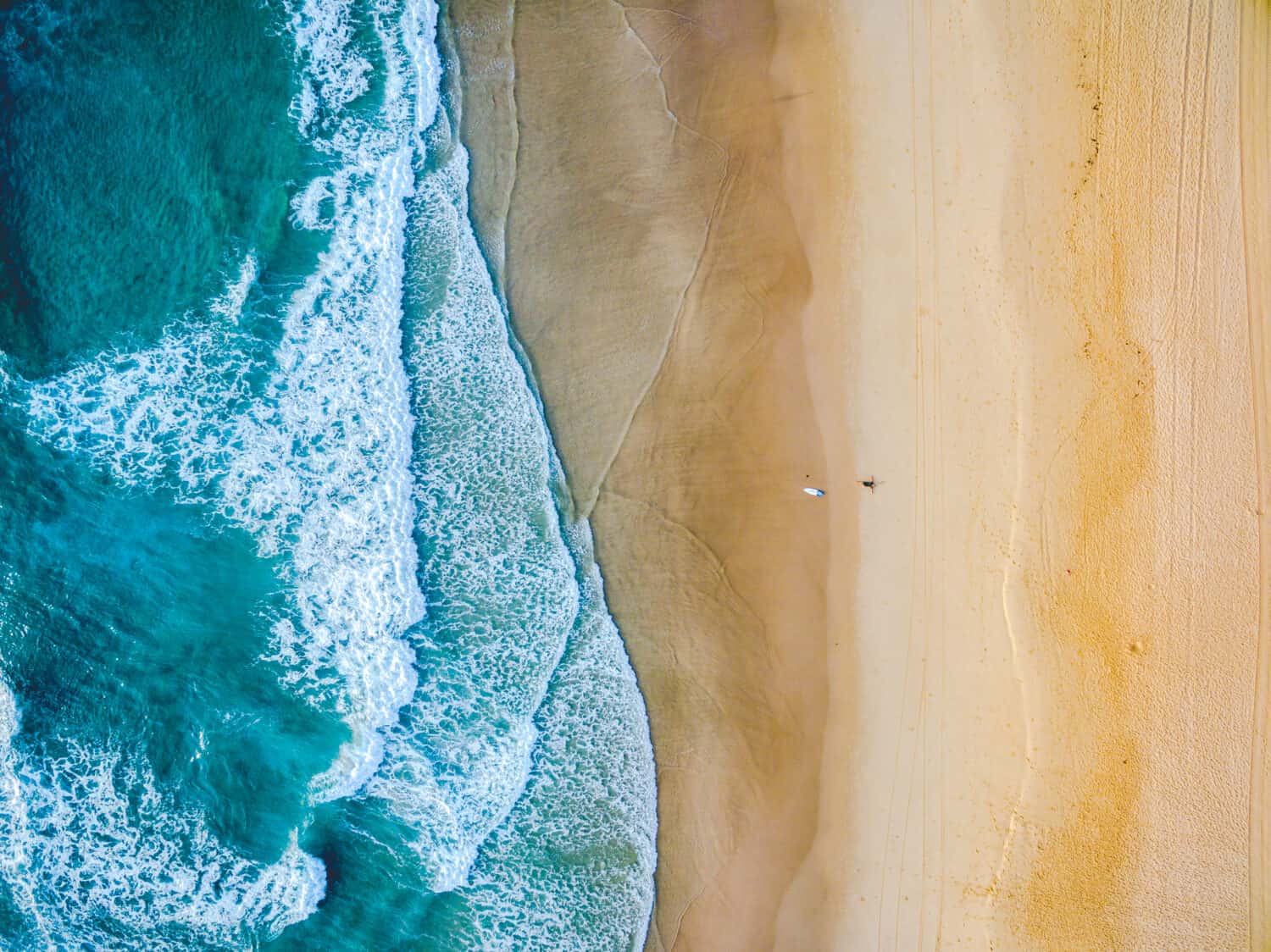
Polihale Beach has soft sandy beaches and luscious waves.
©Taylor Wilson Smith/Shutterstock.com
The Flora and Fauna of Polihale Beach
Polihale Beach and its surrounding dunes and vegetation support a diverse range of flora and fauna. It has a mild tropical climate, and many plant species, such as the naupaka and morning glory, have adapted to thrive in this favorable environment. You can spot many birds here, including native Hawaiian birds like the Kōlea (Pacific golden plover) and the endangered Nēnē (Hawaiian goose) patrolling the shoreline.
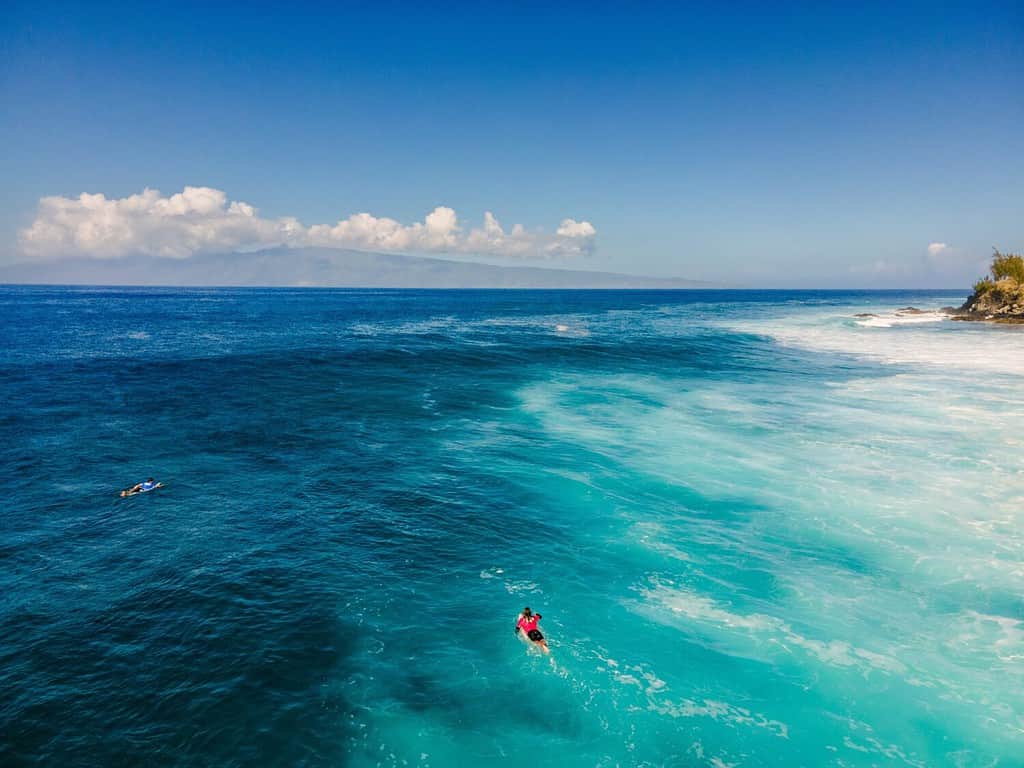
Polihale Beach is a remote wild beach and has plenty of activities to enjoy.
©Andrew Allen Media LLC/Shutterstock.com
Conservation of Polihale Beach
Polihale Beach, like many natural treasures, has faced challenges and threats over time. Most of which have been caused by people. Irresponsible human activities, such as littering, vandalism, and off-road driving, have had adverse effects on the delicate ecosystem and the beach’s environment. These activities disrupt the area’s natural balance and damage culturally significant sites, artifacts, and well-being.
Cultural Importance of Polihale Beach
For the Kānaka Maoli people, Polihale Beach holds profound cultural and spiritual significance. This sacred land is steeped in ancient traditions and stories passed down through generations. It is believed to be a place connecting the earthly realm to the spiritual world and a home and resting place for many Native Hawaiians.
Throughout history, Polihale Beach has been the site of important ceremonies and rituals, and ways of life. The beach’s serene beauty and breathtaking vistas evoke a deep sense of reverence and respect. These lands are sacred to the Kānaka Maoli people. Moreover, they have fostered a strong cultural bond with their ancestors and natural surroundings.
Conservation of Polihale Beach Today
Polihale Beach holds immense cultural significance to the Kānaka Maoli people. The beach and surrounding areas have been honored by generations of Native Hawaiians, making it a sacred and spiritually significant place for these people. The beach and its cultural heritage are of utmost importance to the local community, as well as to conservation organizations and the Hawaii Department of Land and Natural Resources Division of State Parks system.
Various entities working together have implemented conservation efforts to safeguard the natural beauty and cultural importance of Polihale Beach. These efforts aim to protect the delicate coastal ecosystem, native flora and fauna, and the historical and archaeological sites that bear witness to the Kānaka Maoli people and the island’s rich past. Furthermore, through a combination of education, restoration projects, and responsible management, these conservation initiatives are helping to ensure that this treasured and endangered landscape remains preserved for future generations.
Responsible Tourism and Respect for the Sacred Land of Polihale Beach
As visitors to Polihale Beach, it is paramount to understand and honor the cultural importance of this sacred land to the Native Hawaiians. Respecting the land itself is paramount, in addition to the customs, traditions, and spiritual beliefs associated with the area, and is essential in preserving its integrity and aiding in the protection of the cultural heritage here.
Visitors are always welcome. However, actionable consideration is needed to minimize the impact on the environment and local communities. Visitors are asked to respect the lands by practicing responsible tourism, adhering to park regulations and guidelines, and adhering to the expressions of the Native Hawaiian community. This includes but isn’t limited to respecting local communities, being mindful of energy, avoiding off-road driving, staying on designated paths and trails, refraining from disturbing wildlife and plant life, and properly disposing of waste. Practicing the principle of Leave No Trace is a great reference point for protecting the environment.
Finally, by embracing a mindset of reverence and understanding, visitors can contribute to the conservation efforts and become stewards of this precious land, helping to ensure that Polihale Beach and its cultural significance are protected and preserved.
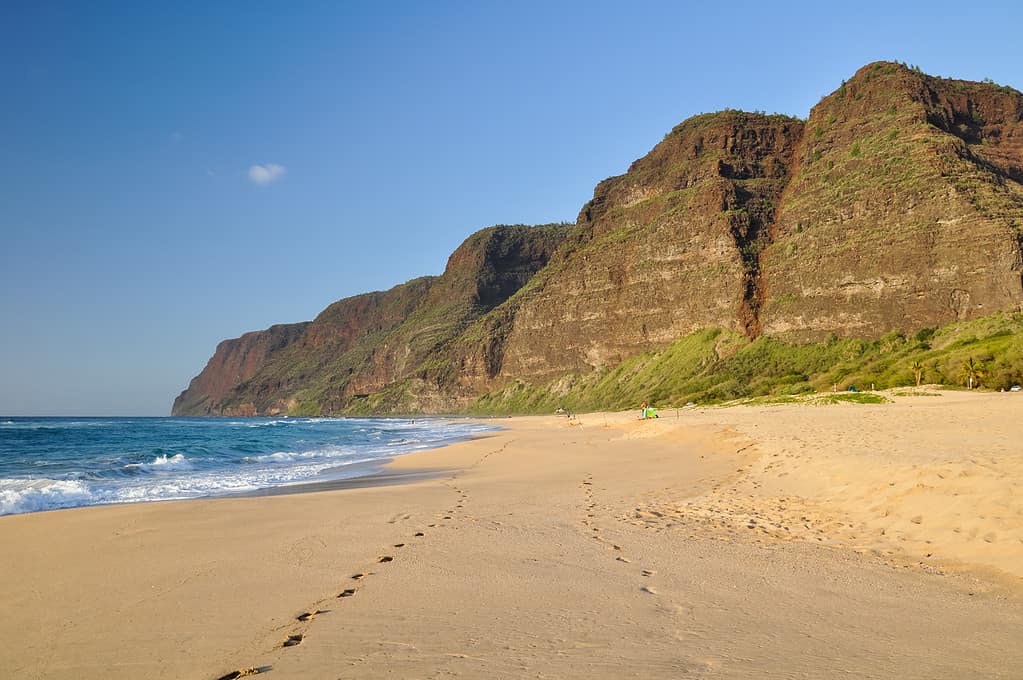
Polihale Beach is located on the western side of Kauai.
©wallix/iStock via Getty Images
Things to Do at Polihale Beach
Polihale Beach in Hawaii offers an array of popular experiences, making it a year-round haven for those seeking to get outdoors and experience Hawaii. Moreover, its expansive shoreline and stunning backdrop of the Na Pali Coast attract visitors seeking an unforgettable beach experience.
Hawaii is primarily distinguished by two seasons due to its subtropical climate. They include the dry season, summer, and the wet season, winter. Polihale Beach offers different delights to enjoy. The beach boasts calm waters and sunny skies during the summer, perfect for swimming, sunbathing, and beachcombing. Visitors can revel in the warm weather and observe the abundant marine life. As the winter months arrive, it becomes a spot for surfing as the waves pick up, hiking or other beach activities in cooler weather, and even whale watching. Humpback whales migrate to the Hawaiian waters from November to April, offering a majestic display of breaching and tail-slapping offshore.
Camping is a popular activity at Polihale Beach, immersing visitors in the serene coastal ambiance. The Polihale State Park offers limited camping facilities, providing an opportunity to stargaze at night and wake up to the soothing sound of ocean waves. Furthermore, reservations and permits are required. If visitors abuse the beach, park officials will close access to the park and beach.
Other popular activities include guided tours, boating, kayaking, hiking, snorkeling, swimming, surfing, fishing, and more. Hiking enthusiasts can explore nearby trails, such as the Awa’awapuhi Trail and the Pihea Trail, offering breathtaking views of the Na Pali Coast’s majestic cliffs and lush valleys.
When to Visit Polihale Beach and Responsible Tourism
If you’d prefer to avoid crowds, the best time to travel to Polihale Beach is during the least popular months. This includes January, February, April, May, September, October, and November. January and October primarily being the least busy months for tourist traffic. The weather is often pleasant, if not rainy, and there is less tourist traffic. Moreover, this allows for a more peaceful and intimate experience with the beach’s natural wonders.
Responsible tourism is crucial to preserving the natural beauty and cultural heritage of Polihale Beach. Visitors must respect the delicate coastal ecosystem by following Leave No Trace principles. This includes but is not limited to staying on designated paths and avoiding trampling on dunes and vegetation. Visitors must properly dispose of litter and waste to protect the animals and the environment.
Finally, in honoring Hawaiian land, culture, and communities, visitors should take the time to learn about the cultural significance of the area. They can show respect by observing local customs, not disturbing cultural sites, and seeking permission before visiting private lands.
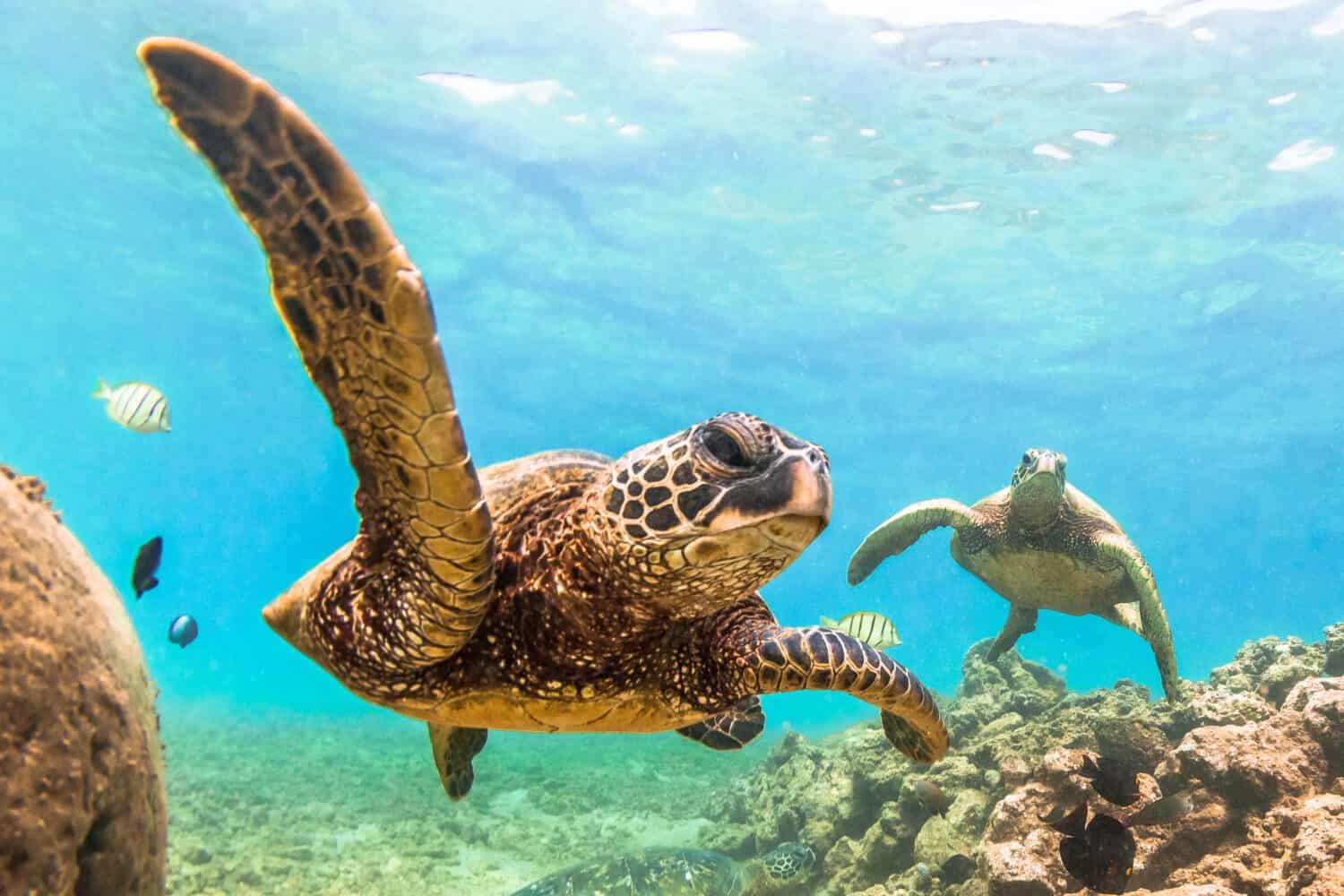
Green Sea Turtles are common at Polihale Beach.
©Shane Myers Photography/Shutterstock.com
Animals Found at Polihale Beach
Polihale Beach in Hawaii boasts diverse marine life, ranging from common year-round residents to rare and uncommon visitors. The beach’s pristine waters and coastal habitats provide a sanctuary for a multitude of species. Furthermore, by respecting and preserving the delicate marine ecosystem, we can continue to cherish and protect the rich biodiversity in and around Polihale Beach for generations. From vibrant tropical fish to majestic sea turtles, this idyllic location teems with life in and around its waters.
Green Sea Turtle (Chelonia mydas)
The green sea turtle is an iconic resident of Hawaii’s coastal waters. Their Hawaiian name is Honu. These graceful creatures can live around Polihale Beach, where they come to bask in the sun on the sandy shores or feed on seaweed in the shallows. Furthermore, as a year-round resident, the green sea turtle plays a crucial role in maintaining the health of the marine ecosystem.
Hawaiian Spinner Dolphins (Stenella longirostris longirostris)
This subspecies is also known as the gray spinner dolphin or Nai’a in Hawaiian. They are year-round residents here. The Hawaiian spinner dolphin subspecies is less common worldwide and found mainly in the Hawaiian Islands. They share many characteristics with the more widespread spinner dolphins but are genetically distinct. These dolphins exhibit unique behaviors.
Moorish Idol (Zanclus cornutus)
The striking Moorish idol, or Kihikihi in Hawaiian, is a popular species in Polihale Beach waters. Its distinctive black, white, and yellow coloration makes it easily recognizable. Moreover, these fish glide gracefully among coral reefs and rocky outcrops, feeding on algae and small invertebrates.
Surgeonfish (Acanthuridae family)
Several species of surgeonfish, also known as tangs, inhabit the waters near Polihale Beach. These brightly colored fish play a vital role in maintaining coral reef health by consuming algae. Furthermore, the convict tang (Acanthurus triostegus), or Manini, and the goldring surgeonfish (Ctenochaetus strigosus), or Kole, are two common surgeonfish in this area.
Hawaiian Triggerfish (Rhinecanthus rectangulus)
Hawaiian triggerfish are fascinating inhabitants of Polihale Beach’s waters. Their Hawaiian name is Humuhumunukunukuāpuaʻa. They have powerful jaws and aggressive behavior when threatened and are important members of the coral reef community.
Hawaiian Monk Seal (Monachus schauinslandi)
The Hawaiian monk seal, known in Hawaiian as ‘īlio holo i ka uaua, is a rare and endangered species that occasionally visits the shores of Polihale Beach. As one of the most endangered marine mammals in the world, the presence of a Hawaiian monk seal is a special and protected event. Moreover, visitors must keep a safe distance from these animals to ensure their well-being.
Humpback Whale (Megaptera novaeangliae)
During the winter months, humpback whales embark on their annual migration to the warm waters of Hawaii. Also known as Koholā, they are not permanent residents. Though they are a breathtaking sight when spotted around Polihale Beach. These gentle giants put on spectacular displays of breaching and tail-slapping, making them a highlight for lucky observers.
Manta Rays (Mobula alfredi)
Manta rays, or in Hawaiian, Hahalua, are captivating and elusive creatures that occasionally grace the waters around Polihale Beach. With their impressive wingspans, these majestic rays glide gracefully through the ocean, filtering plankton and small fish through their gaping mouths. Encountering a manta ray is a truly memorable experience.
Hawaiian Gallinule (Gallinula galeata sandvicensis)
The Hawaiian gallinule, also known as the ʻAlae ʻUla, is a rare bird species in the wetland areas surrounding Polihale Beach. They have a striking red frontal shield and unique vocalizations.
Hawaiian Hawk (Buteo solitarius)
The Hawaiian hawk, or ʻIo, is the only native hawk species in Hawaii. While they may not frequently visit the beach itself, they are often soaring above the coastal cliffs and grasslands in search of prey.
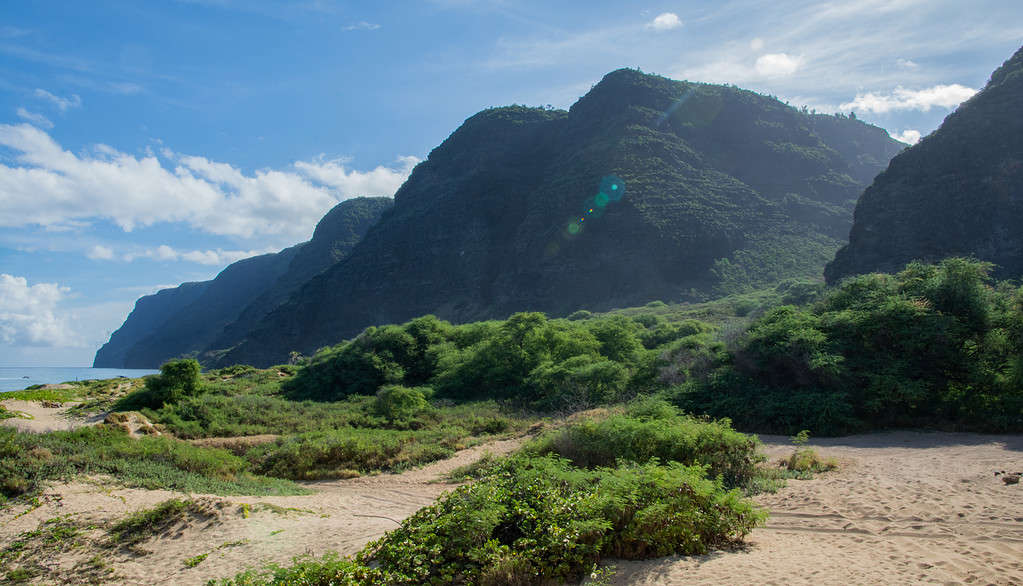
Hawaii has a subtropical climate, resulting in an abundant ecosystem.
©Kyle Kempf/iStock via Getty Images
Plants Found at Polihale Beach
Polihale Beach in Hawaii is a botanical wonderland boasting a variety of plant species both in the water and along its sandy shores. The unique coastal ecosystem, influenced by the island’s volcanic geology and tropical climate, hosts a diverse array of plant life. The sandy shores and coastal habitats provide an ideal environment for these plants to thrive, contributing to the beach’s overall biodiversity and ecological balance.
Naupaka (Scaevola taccada)
The Naupaka plant is a common sight along the sandy shores of Polihale Beach. Its distinctive fan-shaped leaves and small white flowers make it easily recognizable. Furthermore, Naupaka often grows in dense clusters, providing crucial stabilization for dunes.
Hala (Pandanus tectorius)
The Hala tree, also known as the screw pine, is a remarkable plant in the coastal regions of Hawaii. Its long, spiky leaves and unique aerial roots make it an intriguing sight along the edges of Polihale Beach.
Brown Algae (Sargassum aquifolium)
This seaweed is a common type of brown macroalgae that drifts along the ocean’s surface. It often washes ashore on Polihale Beach. Its Hawaiian name is Limu Kala. It provides essential habitat and food for various marine organisms, contributing to the overall health of the coastal ecosystem.
Morning Glory (Ipomoea spp.)
The morning glory, or Pohuehue, is a flowering vine commonly found near the sandy shores of Polihale Beach. Moreover, it has vibrant blooms in shades of purple, pink, and white. This plant adds a splash of color to the coastal landscape.
Loulu Palm (Pritchardia spp.)
The Loulu palm, or Hawaiian palm tree, resides in Hawaii, including Polihale Beach. It has distinctive fan-shaped leaves and a slender trunk. Furthermore, the Loulu palm is an important part of the island’s cultural and ecological heritage.
Akoko (Euphorbia spp.)
Akoko is a unique and endangered plant species endemic to Hawaii. Additionally, its fleshy leaves and small flowers have adapted to the harsh coastal conditions. It is an essential component of the dune ecosystem around Polihale Beach.
Pōhinahina (Vitex rotundifolia)
Pōhinahina, also known as beach vitex, is a low-growing shrub found in the coastal regions of Hawaii. Its silvery-green leaves and purple flowers add to the beach’s scenic beauty. It also helps to control sand movement along the shoreline.
Sea Purslane (Sesuvium portulacastrum)
Sea purslane, or Ākulikuli, is a succulent plant that thrives in the sandy soils near the beach. Its fleshy, reddish leaves and pink flowers make it an attractive addition to the coastal landscape.
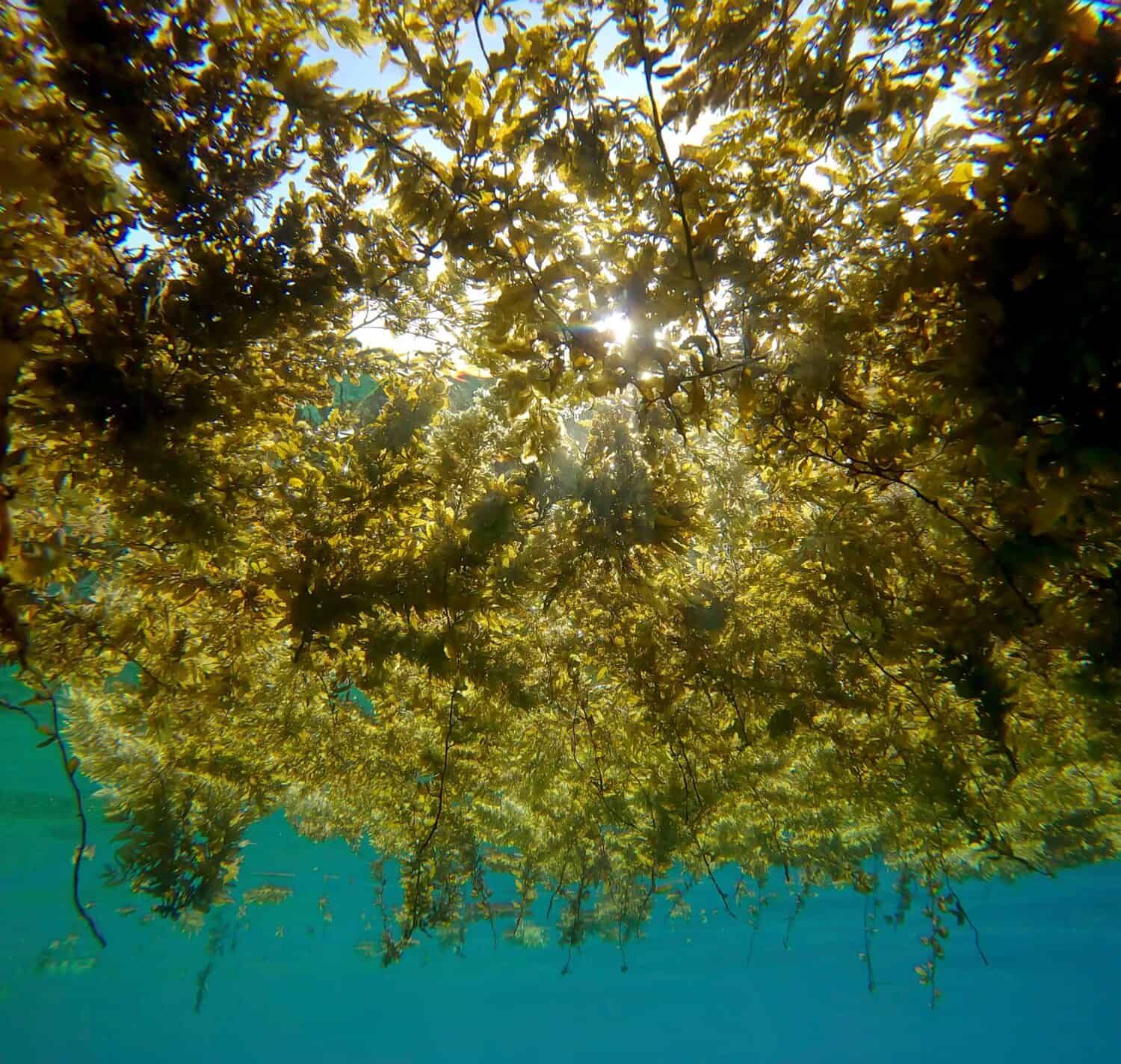
A common plant found at Polihale Beach is
Sargassum aquifolium, a brown macroalgae.
©Andriy Nekrasov/Shutterstock.com
Conclusion
To conclude, Polihale Beach is located on the island of Kauai in Hawaii. It is a majestic coastal wonder teeming with natural beauty and biodiversity. As one of the longest beaches in Hawaii, it stretches approximately 17 miles. It provides a haven for wildlife, plant life, and the Kānaka Maoli people. Its soft, golden sands meet the awe-inspiring Na Pali Coast cliffs, forming a stunning backdrop for a diverse range of plants and animals. Polihale Beach showcases a rich tapestry of life and sacred space for local communities. Here visitors can seek to connect with nature’s wonders and the people who call these lands home. Finally, with ongoing conservation efforts, we can ensure the protection and preservation of this treasured paradise for future generations.
The photo featured at the top of this post is © Taylor Wilson Smith/Shutterstock.com
Thank you for reading! Have some feedback for us? Contact the AZ Animals editorial team.






